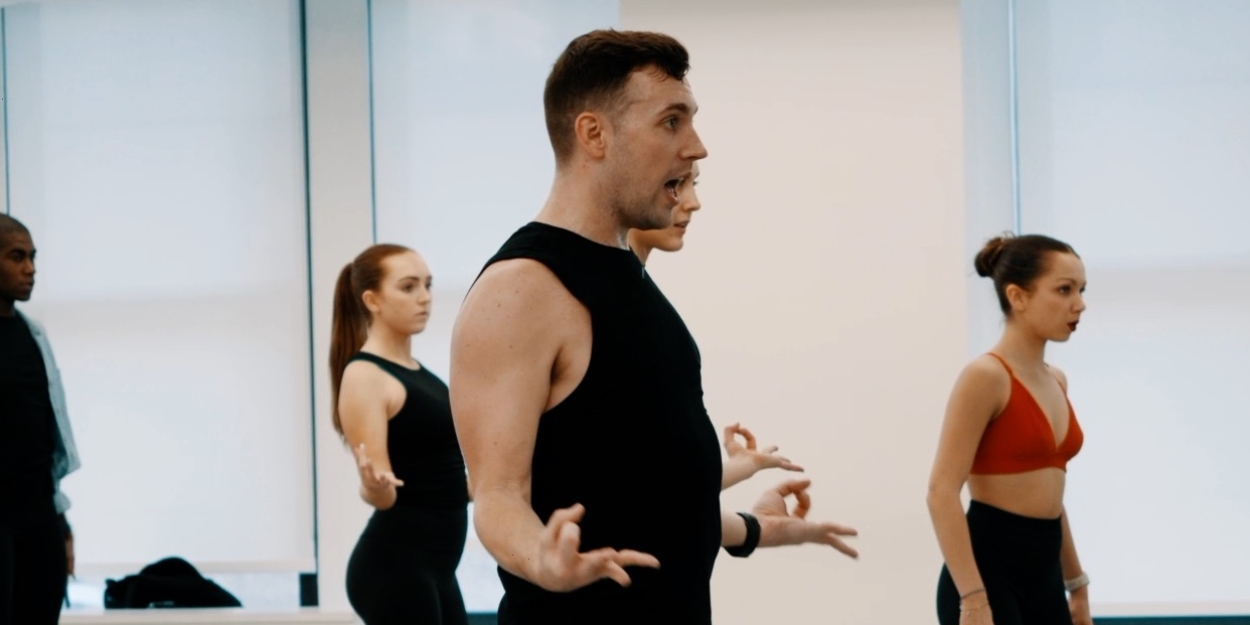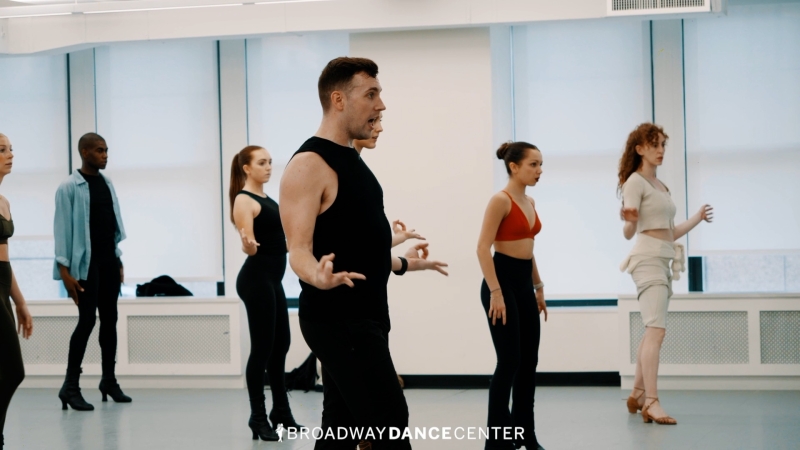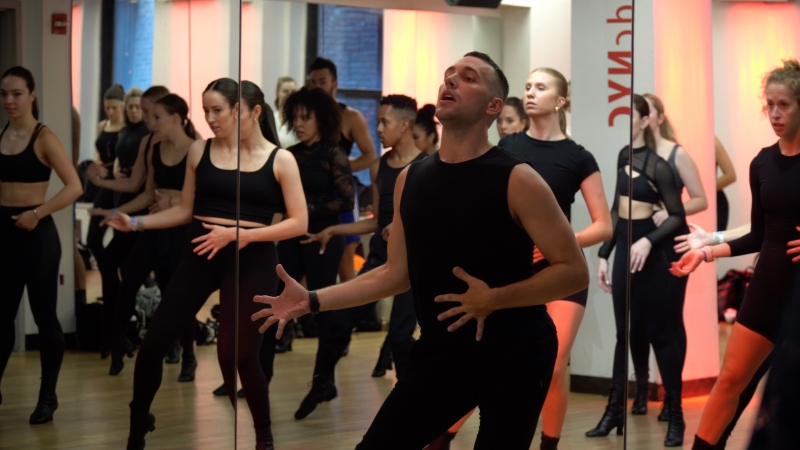Conversations with Creators: Tanner Lane and The Idea of Movement Fusion
Conversations with Creators gives insight into the artist mindset of top industry creatives.

"I enjoy dancing now more than I did when I was younger, especially creating my own movement," says Tanner Lane, a New York based performer and choreographer. He is currently on faculty at Broadway Dance Center where he teaches Theatre Jazz as well as Deviate Dance Convention where he teaches Theatre, Jazz, and Heels. He moved to New York from Florida after attending Florida State University for Musical Theatre. Shortly after moving to the city, Tanner joined the equity Broadway National Tour of Chicago The Musical where he toured both nationally (including Kennedy Center) and internationally (South Korea, Japan, Philippines). In NYC he is the only person to have performed as both a singer and a dancer in the Radio City Christmas Spectacular. This summer he choreographed for the Las Culturistas 2024 Culture Awards with Matt Rogers and Bowen Yang and set a number for an event with Leg Up On Life. Tanner has also had the opportunity to perform around the country regionally in Joseph..., and Billy Elliot (The Muny), Bye Bye Birdie (Lyric Theatre OKC), A Chorus Line (Stages St. Louis), and more.
You've performed in some of the largest shows including Chicago and The Christmas Spectacular, especially in New York and on tour. How did you originally begin to dance?
I started in elementary school. I don't really know why because my family are all sports people, and there's no one in my family that does anything in the arts. I was in first grade and looked up a piano store in a phone book. I called them and brought the phone to my mom, and the guy on the phone was like, your son's asking about piano lessons. I had never mentioned it to her before. She was like, he is? So then we went and I interviewed about five different teachers, because I was crazy and I wanted the best teacher. I started taking piano, and then I wanted to sing. I started doing vocal lessons and went to an after-school camp that also had a theater at a community center. I decided to audition and began performing in shows there.
I didn't start dancing until fifth grade, when I decided I wanted to start taking dance classes. My love for dance snowballed quickly; I fell in love with it. The first year, I only took one class, hip hop, but then I left it, so I wanted to take more. The next year, I went all in, and I was taking around four classes a night, so my whole childhood was all in the arts. I went to a middle school and high school for the arts as a vocal major and danced after school. Once I ended up going for music theater.
Was there a certain point where you knew you’d be pursuing dance, vocals, or anything in the arts?
Probably in middle school. I feel like I knew from an early age that it was what I wanted to do. Just because I went to a middle school for the arts, I was taking dance and then after school, I would do the shows, so I would be there later and after that, I would go take dance classes. So I was just doing it all day, every day, and there was nothing else really. I never had any other interests or anything that I felt like doing. It just felt right. As far back as I can remember, it's all I've wanted to do.
How would you describe yourself as a performer and a dancer now?
I love to be full out. I love the feeling of exhaustion and going as hard as I can, but I also feel like so much of what I encompass as a performer is also being a choreographer. I don't think I really noticed it until I started doing more choreography. That was the amalgamation of all my influences that I've had and the things that I've done and how it's shaped the way I move.
When it came to choreography, because I did the Chicago tour where I was doing a lot of Fosse movement, I was always interested in the movement and style. Then I did Christmas Spectacular at Radio City which has a lot of precision movement and Fosse inspiration as well. When I moved to the city, I used to take a lot of street jazz, and I began taking heels classes because I thought it would be fun. I fell in love with heels, and then I started teaching heels. I have different backgrounds that have all come together. Now, as I’ve gotten older, I can see the influences and the way I approach movement and perform, which I never noticed when I was younger.

How would you define your movement style and what are your influences?
I’ve been calling it ‘Fosse fusion’ with my friends and people, and that’s the closest way to describe it that I can think of. It’s a little bit of jazz and heels, mixed with a lot of styles. I always go back to Fosse-based movement and use elements of angles and isolations which seem to seep its way into the way I want to move. I’ve had a lot of fun with finding ways to have my movement be Fosse-inspired as opposed to Fosse-based, per se. It’s not necessarily classical Fosse movements or traditional. It’s more the essence of what I feel Fosse was for me in terms of shapes, isolations, and dynamics. I kept trying to find, how can I make this a little bit different? Or how can I make this fit with this hip hop song I’m doing? The fun part is playing around and experimenting with something I hadn’t really seen done before. I decided to just try it.
I started teaching theater classes on my own in the city with some friends for fun, and one day I decided, I’m going to do a Fosse-based combination to a Beyonce song. I told my partner that and he was like, that could be cool, you should try it. In my mind, I was wondering, are people going to hate this? Is this going to be weird? I also had the thought, am I allowed to do this? I mean, there are no rules, but I just doubted it a lot. Then I taught it, and people seemed to really enjoy it. It took off from there and I started exploring it more. It became my thing. When I first started teaching Beyonce Fosse fusion specifically, for some reason, that was what people wanted. I ended up doing five different Beyonce Fosse combinations. Now I’ve branched out to all kinds of music, but those first few had the biggest impact on me. I did the Chicago tour when I was younger, but now in my 30s, looking back at how I danced in my early 20s, I can see the change and difference and it feels so good. It’s been an interesting journey.
Can you talk a little bit just about like the experience of booking Chicago The Musical, and your experience in the show?
I booked a tour when I was 23, maybe six months after I had moved here, and I was excited. I don’t think I’d ever seen this version of the stage production before. I had seen the movie, and I just knew that I enjoyed doing the movement I had learned, like the combination for ‘All That Jazz’ at a workshop type of thing, not an audition. I went to an audition for it a month later because I realized, ‘Oh, that felt good.’ I felt good about myself doing the movement and realized I should audition. I didn’t know if I was the right type or right body for it, and I was young. Luckily, I went and had an amazing experience. Being on tour had a big impact on me especially because I was a younger dancer. Fosse is challenging because it requires you to sometimes do less and be very specific with your movement, which I think can be hard for a younger dancer, because you want to be dancing at 200% all the time.
I watched and learned from other performers who were able to embody that so well. I remember Dylis Croman coming in as Roxy, who I already looked up to from watching her do the trumpet solo in Fosse. Watching her simply stand on stage and still command a presence and energy in the way that she held her body, even just the smallest movements, influenced me a lot with exploring dynamics. Even today, I feel like it’s shaped me a lot with how I dance and I still always think of her.
I still love to be full out. I love dancing big and all of that, but I feel when I was younger, I was missing some of the textures and dynamics. Chicago helped me find the other side of myself as a dancer, and now I have balance, which I enjoy.

How do you approach your ideas and movement? What is your process like when preparing to teach a class?
I'm very visual. When I start choreographing something, I usually put on headphones and sit, listen, and picture things in my mind. A lot of times I'll see a shape or a phrase that I know I want, and sometimes I’ll refer to things I’ve seen or pull from more traditional movements for Fosse or with hip hop. I’ll try to explore and see how I can embody the essence of it without necessarily doing the exact depth.
I like to play with syncopations and rhythm a lot. In my fusion of movement, sometimes it’ll end up being shifting weight or accenting a certain part of the movement more with the music to match the rhythm. I play around and see what feels right. Sometimes I’ll just look in the mirror and find shapes I like and see where I go from there.
What is your favorite part about teaching when you’re in the room for the hour and a half?
My favorite part of teaching at Broadway Dance Center in New York, is working with professionals and all the amazing dancers that come through or live in New York. I feel so inspired every time because there's so many phenomenal and diverse dancers. I’m teaching a fusion of movement and seeing how each person puts their take on it, and sometimes the movement morphs into something I like even more.
The dancers’ take on my movement may influence the way I create another piece of choreography, or even change it. Everyone brings their own background to the movement, and seeing people do my choreography in an original and unique way is what inspires me the most. I have new dancers come to class that I’ve never seen before, and simply watching them inspires me to choreograph a specific combination for another class. New York is so special because there are so many professionals from different backgrounds who are amazing at their craft. Going to teach class every week and watch the best of the best is so exciting for me, and I’ve learned more in the past year than I have in all my years.
What are you most excited for in the future?
I'm most excited to do a full production of a musical as opposed to classes or setting numbers for events. I’d love to work on something where you have an entire story and are and telling a story more through the movement, especially with the style that I've been doing. I would love to do something that is unexpected and find a way to liven it up and find a new take on it.
Is the production something you've been thinking about for a long time now, or an idea you’ve developed since teaching?
It’s something I've wanted to do for a little while, especially since I started teaching in the city within the past year. It’s what I'm working on right now, but it's not what I would have anticipated if you had asked me a year ago. I was still doing Radio City at Christmas, but when Covid started, I went back to school for computer science and I was removed from the business other than Radio City, so I didn't really have any plans to go into it this, but then I kind of fell into it and loved it, and now I'm more excited for this than it happens for anything.

Photo Credit: Headshot by Anthony LaGuardia, All Other Photos by Andre Canseco
Comments

Videos

